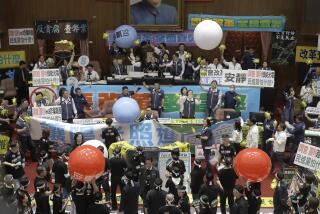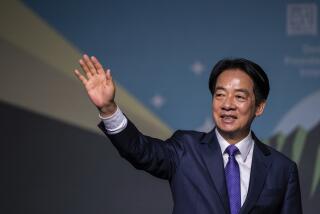Taiwan Opposition Party Pays Official Visit to China
- Share via
BEIJING — A delegation of Taiwan’s opposition Nationalists arrived in mainland China on Monday for the first official visit by the party since it lost a civil war to the Communists more than half a century ago.
The trip comes on the heels of a massive weekend rally in Taipei, the capital of Taiwan, by several hundred thousand people to protest Beijing’s passage of an anti-secession law aimed at preventing the island from declaring independence.
The Nationalist Party -- also known as the Kuomintang, or KMT -- was once the archenemy of Beijing. Now it hopes to play the role of peacemaker.
“They are trying to send the message that the KMT is for peaceful resolution of cross-strait tensions, despite a long history of misunderstandings and high emotions,” said Andrew Yang, head of the Chinese Council of Advanced Policy Studies, a Taipei think tank.
In some ways, the trip is a reminder of how much the Nationalists and Communists have in common. Both were founded on the mainland and believe that Taiwan is part of China.
Ever since the Nationalist Party lost its grip on power in China and fled to Taiwan in 1949, returning to power on the mainland has been its ultimate goal. Taiwan’s ruling Democratic Progressive Party changed cross-strait relations when it swept into power in 2000 and began advocating for a more separate identity for the island of 23 million people.
To the Communists, who have long threatened to take Taiwan back by force if necessary, the Nationalists may now appear to be the lesser of two evils.
“We know the KMT may be anti-Communist, but they are not anti-China,” said Xu Bodong, a Taiwan expert at Beijing Union University. “They have always maintained that there is only one China and they are against Taiwan independence.”
Chiang Pin-kung, 73, the Nationalist Party vice chairman who heads the 30-member delegation, said the group’s goal was to push for reconciliation by showcasing the ties between the island and the mainland.
On the delegates’ agenda is a visit to the southern city of Guangzhou to pay their respects to the graves of Nationalists who died during an uprising against the Qing dynasty a century ago. They also plan to stop in the capital of Jiangsu province, Nanjing, the party’s former seat of power, to honor the tomb of Sun Yat-sen. He is recognized by both the Communists and Nationalists as the founding father of modern China.
The trip is timed to coincide with a festival devoted to maintaining gravesites, celebrated on both sides of the Taiwan Strait.
“They are trying to show that Taiwan’s roots are in China and that we are all Chinese,” Xu said.
The Nationalists also are expected to meet with Taiwanese businesspeople working on the mainland and push for closer economic ties. They plan to end their five-day trip in Beijing, where they hope to meet with high-level Chinese officials and pave the way for a mainland visit this summer by Nationalist Party Chairman Lien Chan.
The last time the Nationalists and Communists joined hands was during World War II, when they battled Japan. It remains to be seen if this visit signals a new partnership to end tensions that have plagued the two sides for more than five decades.
This could prove to be the last chance for an old generation of Nationalists to play a role in cross-strait politics as a new breed of Taiwanese with fewer links to the mainland begins to take their place.
“The older KMT members are all born in China and grew up in China,” said Arthur Ding, a research fellow at the Institute of International Relations at National Chengchi University in Taipei. “They consider themselves Chinese. The new generation is more mixed. They probably don’t see unification as an ultimate goal.”
More to Read
Sign up for Essential California
The most important California stories and recommendations in your inbox every morning.
You may occasionally receive promotional content from the Los Angeles Times.










